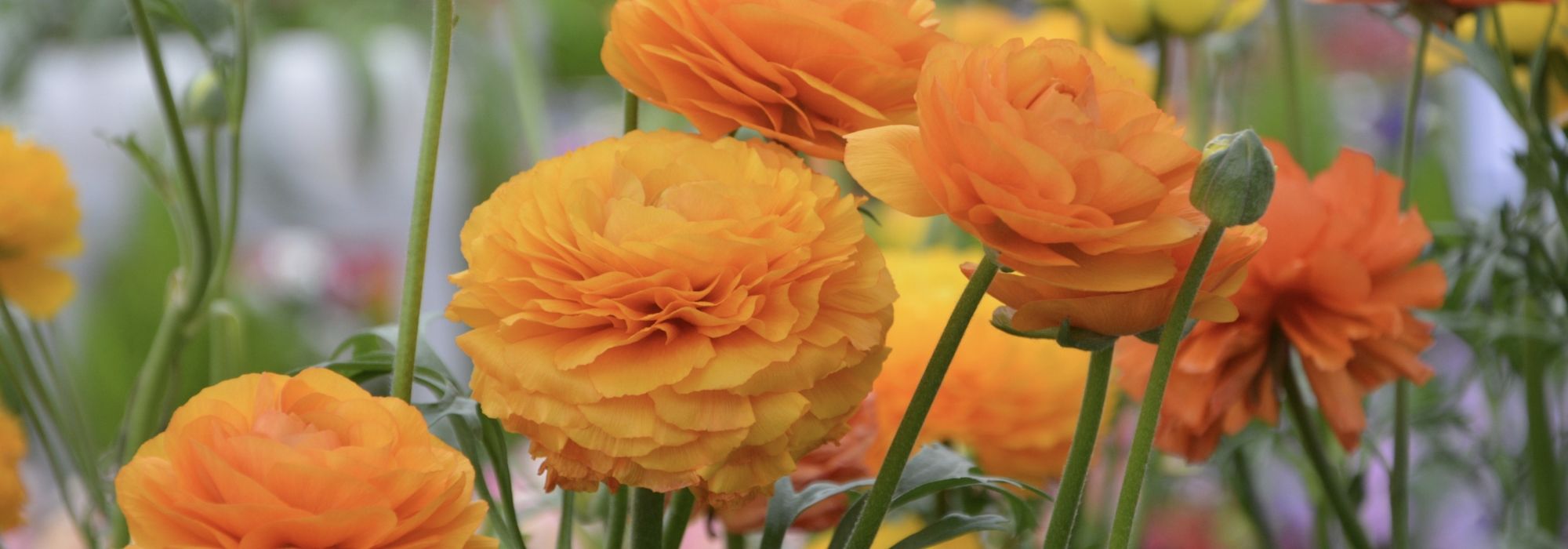
Florist's ranunculus: planting, cultivation, care and use
Contents
Ranunculus in a nutshell
- Florist’s ranunculi are tuberous perennial plants with bright colours and single or double flowers appearing from April to June.
- Pink, red, yellow, orange, white, mauve or even green, ranunculi display a multitude of striking colours.
- They make perfect bouquets thanks to their long vase life.
- They are also very attractive in the garden, in a pot or a border.
- Floriferous and requiring little care, ranunculi do, however, dislike overly sunny positions.
A word from our expert
Bright, varied-coloured flowers with attractive shapes, florists’ ranunculus (Ranunculus asiaticus) bring the garden to life at the heart of spring. Red, orange, yellow, white, mauve, green or even bicoloured, these flowers charm with their shimmering display. Flowers are often very double and, with their many crinkled petals, evoke the charm of old-fashioned roses. Ranunculus will find a place in the garden, in a border, a flower bed or a pot, as well as in a bouquet where their long vase life will keep interiors in bloom for a long time.
Relatively easy to care for, florists’ ranunculus offer abundant flowering provided a few simple precautions are followed. These tuberous and perennial plants thrive in humus-bearing, well-draining soil, in shady or sunny situations. However, these graceful and elegant plants are quite tender and should be overwintered in regions with harsh winters.
Ranunculus form a diverse genus with several hundred species, but best known are florists’ ranunculus (Ranunculus asiaticus) which today offer a wide range of shapes and colours.
Description and botany
Botanical data
- Latin name Ranunculus sp.
- Family Ranunculaceae
- Common name Ranunculus
- Flowering April to June
- Height between 35 cm and 60 cm
- Exposure partial shade, sun
- Soil type rich, humus-bearing, moist but well-drained
- Hardiness Low (down to -10°C)
Genus Ranunculus is very diverse with currently 1,558 accepted species. Appearing in many forms, these hundreds of species are native to numerous countries with varied environmental conditions. Some can even withstand harsh winters of glacial regions (Ranunculus glacialis). In France, more than 300 species are present, including well-known Ranunculus acris, also called buttercup.
Ranunculus, like other garden plants (for example anemones), belong to family Ranunculaceae. It is this genus that gave its name to the family. Among the many existing species, only a small proportion are cultivated today. Most common species is the florist’s ranunculus (Ranunculus asiaticus). It is native to Mediterranean region (Aegean Islands, Egypt, Crete, Greece and Libya) and therefore dislikes overly harsh winters.
Ranunculus are herbaceous, tuberous perennial plants. They have several small elongated tubercles, linked together, forming an underground storage organ called a “griffe”. Over time, the plant produces new tubercles that can be used to divide plants. Each tubercle is multiflorous and can produce up to 10 flowers, depending on variety.
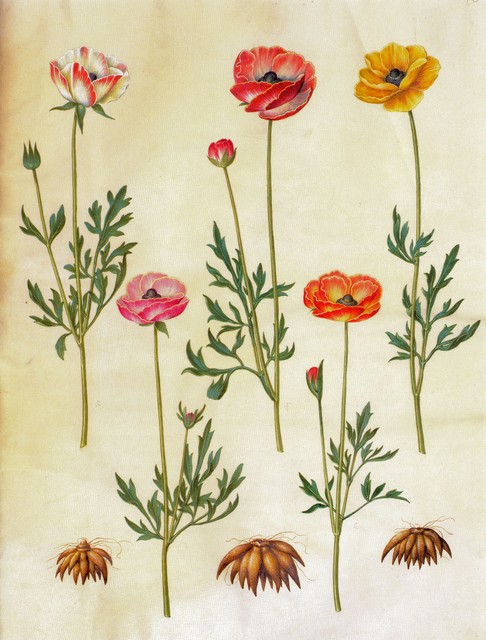
Ranunculus asiaticus – botanical illustration
Stem of some varieties can be fairly long, an advantage for making bouquets, but plant generally has fairly low habit and rarely exceeds 50 cm.
Ranunculus has deciduous rosette foliage. Strongly divided into three lobes, leaves vary in colour depending on variety, often dark green or medium green. They measure 10 to 15 cm. Fine, stiff stems rise above a cluster of basal leaves, each producing a single flower, particularly suited to vase use. Other species also have cauline foliage borne on stems. This is notably the case for Ranunculus acris, the buttercup. Flowers appear 120 days after planting for modern varieties. Flowering period is long, up to 6 or 7 weeks per plant.
Most garden ranunculus have globular, very double flowers. Others are semi-double and many botanical species have single flowers. In double-flowered varieties, stamens have been transformed into petals during breeding, making these plants male-sterile. They can, however, produce seeds if fertilised by a flower with stamens. Fruits then form that resemble small capsules. Seedlings from horticultural varieties differ greatly from their parents, especially if several varieties are present in the garden.
Most widely marketed varieties belong to species Ranunculus asiaticus. They are also called florist’s ranunculus, Asiatic ranunculus, garden ranunculus or oriental ranunculus. Range of colours available, result of intensive breeding, is now quite wide: yellow, red, orange, white, mauve, green… or bicoloured with flowers whose petal edges are trimmed with a second colour. Flowers generally measure 3 to 5 cm in diameter.
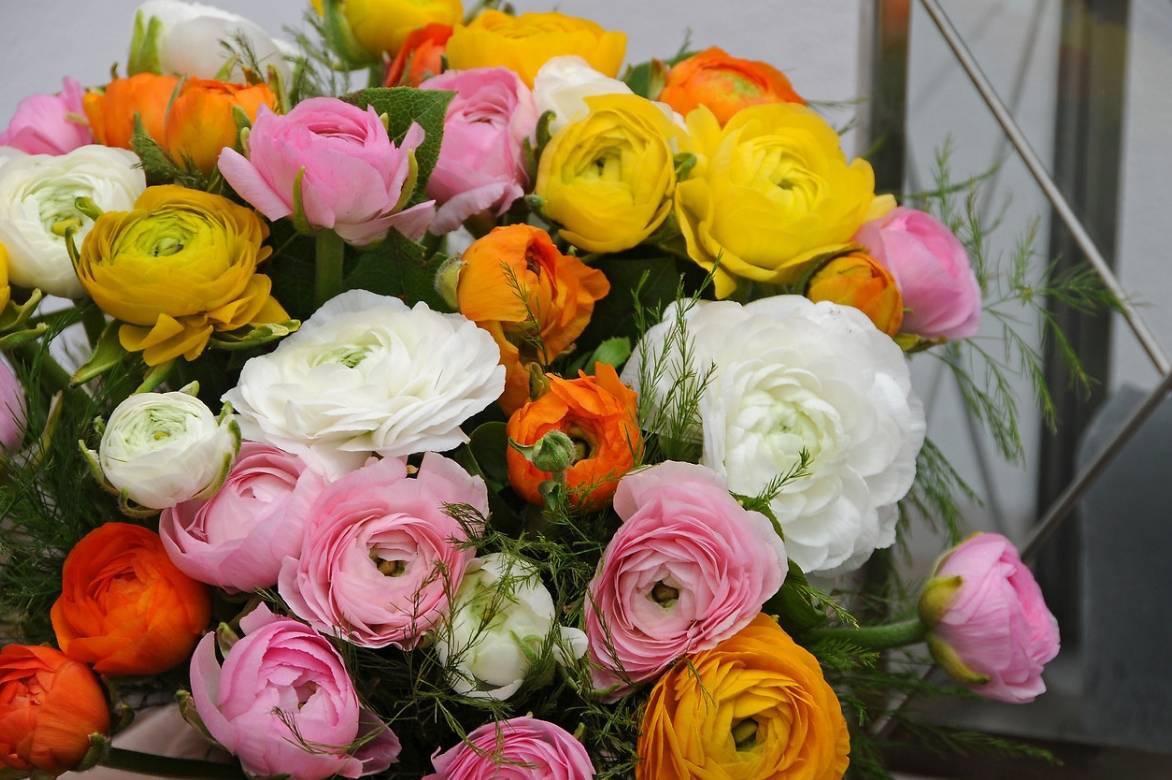
Various colours of florist’s ranunculus, something for every taste!
Different varieties of ranunculus
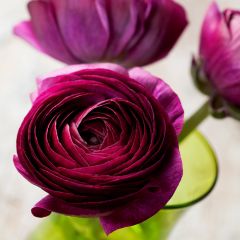
Ranunculus asiaticus Pauline Violet - Persian Buttercup
- Flowering time June, July
- Height at maturity 40 cm

Ranunculus asiaticus White Pink Bicolor - Persian Buttercup
- Flowering time June, July
- Height at maturity 35 cm
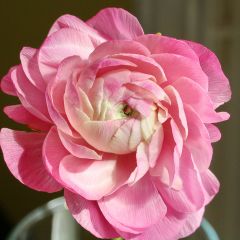
Ranunculus asiaticus Pink-flowered - Persian Buttercup
- Flowering time June, July
- Height at maturity 35 cm
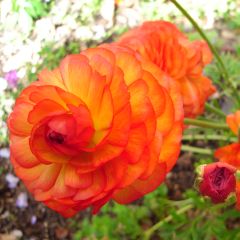
Ranunculus asiaticus Orange - Persian Buttercup
- Flowering time June, July
- Height at maturity 35 cm
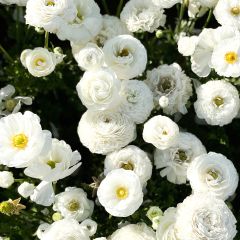
Ranunculus asiaticus White - Persian Buttercup
- Flowering time June, July
- Height at maturity 35 cm
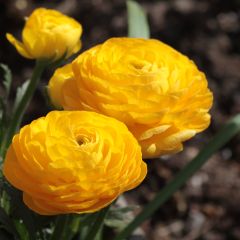
Ranunculus asiaticus Yellow - Persian Buttercup
- Flowering time June, July
- Height at maturity 35 cm
Discover other Ranunculus bulbs
View all →Available in 1 sizes
Available in 1 sizes
Available in 1 sizes
Available in 0 sizes
Available in 1 sizes
Available in 1 sizes
Available in 2 sizes
Available in 1 sizes
Available in 1 sizes
Available in 1 sizes
Planting
Where and when to plant florist’s ranunculus?
Ranunculus thrive in rich, humus-bearing soils. Florist’s ranunculus, however, dislike soils that are too dry in which tubers can rot. Ranunculus prefer sunny or partly shaded positions. Take care with hot midday sun, which can damage flowers. Note, ranunculus do not tolerate calcareous soils. Also favour positions sheltered from wind, as strong gusts can sometimes break long ranunculus stems.
Ranunculus can be planted in garden beds or borders, but they are also excellent plants for containers or under cover for cut-flower production.
Florist’s ranunculus bulbs are planted from late summer through to late autumn. In cold regions you can plant in pots that you will either set in ground once frosts have passed, or keep on a patio.
How to plant?
Ranunculus are relatively large bulbous plants, so aim for a planting density of 16–20 bulbs per square metre. In practice, space each bulb about 10 centimetres apart.
Before planting, if your soil is not free-draining, add sand to avoid tuber rot.
- Rehydrate ranunculus tubers by soaking them for a few hours in water at room temperature. When tubers sink to bottom of container, they are properly hydrated and ready for planting.
- Dig a planting hole for your tubercle and place it at a depth of 5 to 10 centimetres.
- Cover with soil and firm lightly.
- Water moderately, even if substrate is moist.
You can also pre-sprout your tubers in a growing medium in a cool but frost-free place (4–10°C) to speed up flowering by a few weeks. Replant them once they are well rooted.
Further reading on planting bulbs: Planting bulbs, 7 useful and practical tips
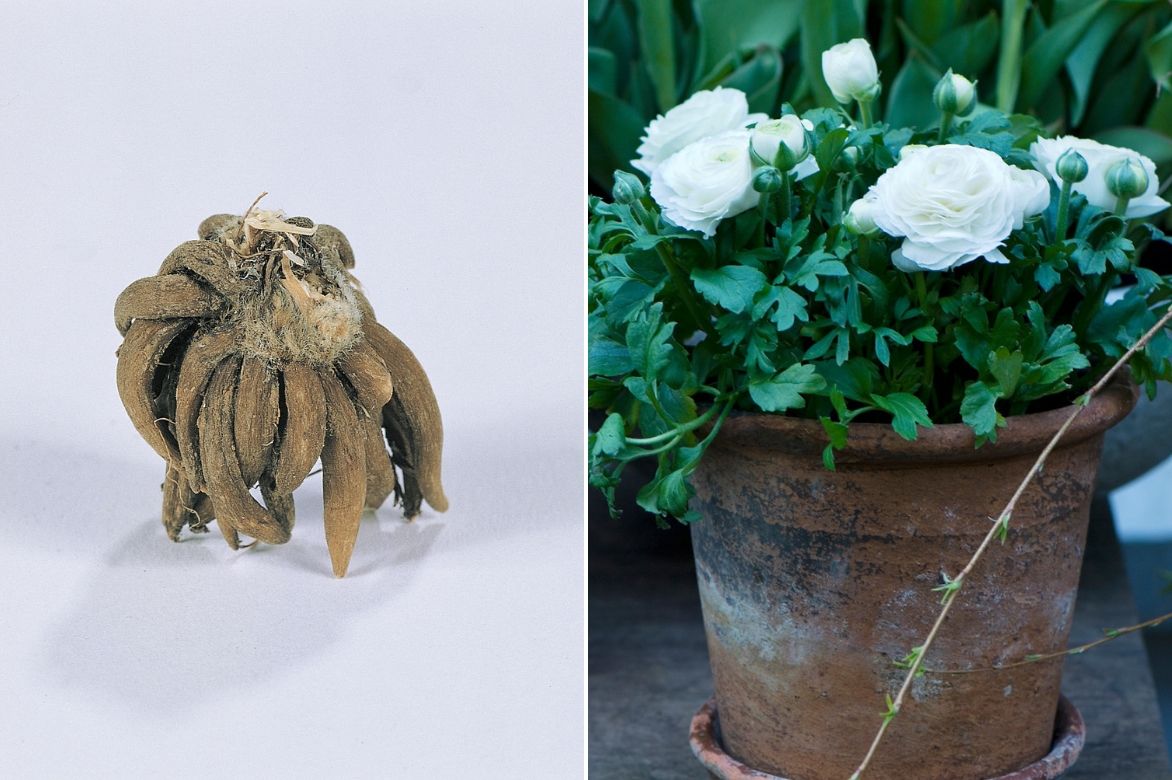
Tuber and potted florist’s ranunculus
Propagating ranunculus
Like many bulbous plants, ranunculi primarily multiply by division of clumps.
Division
This operation is carried out in autumn when you lift your plants to protect them from winter. If you live in an area with mild winters, division is also done in autumn, replanting the new plants directly into soil. First, dig up the stump of ranunculus. Use a cutting knife, carefully disinfected, and cut the tubercles into several fragments. Each fragment must have a dormant bud. If you replant immediately, plant each part separately, remembering to water to help the plants establish. Multiplication rate of ranunculus is relatively low, so if you want a mass effect, do not hesitate to plant a large number of tubercles.
Sowing
If your flowers have been pollinated, they will produce small capsules containing seeds. It is possible to use these seeds to multiply your ranunculi, bearing in mind that new plants can differ greatly from their parents and from each other, especially if several varieties of ranunculus are present in your garden. Seeds have a short seed viability and should therefore be sown as soon as possible. Cover the seeds with a thin layer of soil and water thoroughly. Keep the sowing moist until germination, without excess. Seedlings will appear after about a month but expect to wait 1 to 3 years before seeing first flowers. Ranunculi, like other bulbous plants, must pass through a juvenile phase before they can flower. This juvenile phase ends when the bulb has grown large enough to produce a flower, so allow time for your seeds to develop.
Care
Florist’s ranunculus are plants sometimes not very hardy in cold regions and should be stored in a frost-free place over winter. In autumn, before first frosts, lift your ranunculus tubers from the soil. After removing any rotten tubercles, store them in a cool, dry place protected from frost. If winters are mild in your area, it is possible to leave ranunculus in place, preferably after mulching them.
During summer, cut off faded flowers to encourage a repeat flowering (new flower stems will be produced). Do not cut the foliage, it is essential for building reserves in the tubercle!
In terms of nutrition, ranunculus are not demanding, a fertiliser feed is therefore not necessary during flowering.
Garden ranunculus is highly susceptible to powdery mildew, varying according to cultivar. From bud stage, leaves can become covered with a white powdery coating, a characteristic symptom of this disease. Treat at first symptoms or preventatively with a horsetail decoction. Ranunculus are also vulnerable to slugs, snails and aphids. For an ecological solution against aphids, treat with black soap. Discover our 7 effective and natural ways to combat slugs.
Companion plants for ranunculus
In the garden
Bright colours of ranunculus combine very well with contrasting colours, for example yellow ranunculus with blue flowers, such as forget-me-not or muscari. Ranunculus also pair well with poppies or anemones that share the same habit and similarly shaped flowers. You can also plant ranunculus in colour mixes, which will give your garden a bright, lively feel.
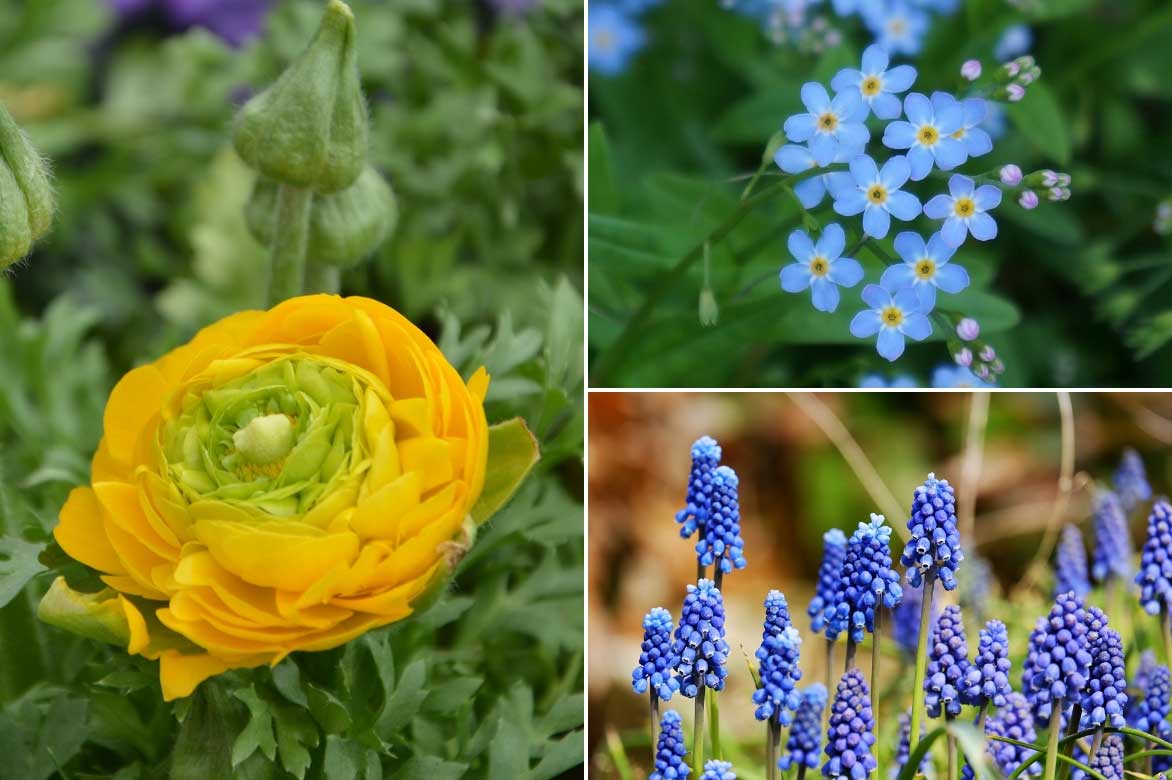
An example of spring pairing: yellow-flowered ranunculus, forget-me-not and muscari
In bouquets
Florist’s ranunculus combine wonderfully with double old garden roses or peonies; the three species share very double, full and rounded flowers. Add gypsophila to this romantic bouquet to bring a touch of lightness. Ranunculus also pair well with Caen anemone or with foliage such as Eucalyptus or Asparagus, with which the large globular flowers of ranunculus will form a lovely contrast.

Bouquet of ranunculus, notably paired with tulips
Did you know?
The scientific name of buttercups Ranuculus comes from the Latin ‘rana’, meaning little frog, and refers to the many aquatic species of buttercups.
Useful resources
- Discover our ranunculus collection
- Advice sheet: Choosing a ranunculus: our buying guide
- Advice sheet: How to grow a florist’s ranunculus in a pot?
- Learn more about botanical species of ranunculus
- Advice sheet: Bulb size: understand to choose better
Frequently asked questions
-
Plantez-les avec les « doigts » (les pointeaux/racines) orientés vers le bas et la partie en forme de coupelle (la face concave, d’où sortira la pousse) vers le haut. Si vous n’êtes pas sûr : posez le tubercule sur le côté — il pourra s’orienter en poussant, mais idéalement mettez la coupelle vers le haut pour limiter le risque de pourriture. Conseils rapides : - Trempez les tubercules 2–4 heures avant plantation pour les réhydrater. - Enterrez à 3–5 cm de profondeur, espacez 8–12 cm. - Sol bien drainé, exposition ensoleillée à mi-ombre, arrosages modérés. - Protégez des gelées tardives si vous plantez au printemps.
You will receive your ranunculi in the form of a claw, slightly like an octopus with tentacles. Plant the claw facing downwards with the tentacles directed towards the soil.
-
Should I water my ranunculus?
Florists' ranunculus cannot tolerate drought but also suffer from excess moisture, which causes the tubers to rot. In dry summer weather, water regularly, allowing substrate to dry out between waterings. If your ranunculus are in pots, water more frequently, about once a week.
-
How can I extend vase life of ranunculus?
Florists' ranunculus have a long vase life, up to 3 weeks, if you take care of them. When arranging the bouquet, cut flower stems at an angle to improve water uptake by flowers. Change water regularly, every 2 to 3 days, and recut stems if necessary, as they can rot quite quickly.
- Subscribe!
- Contents
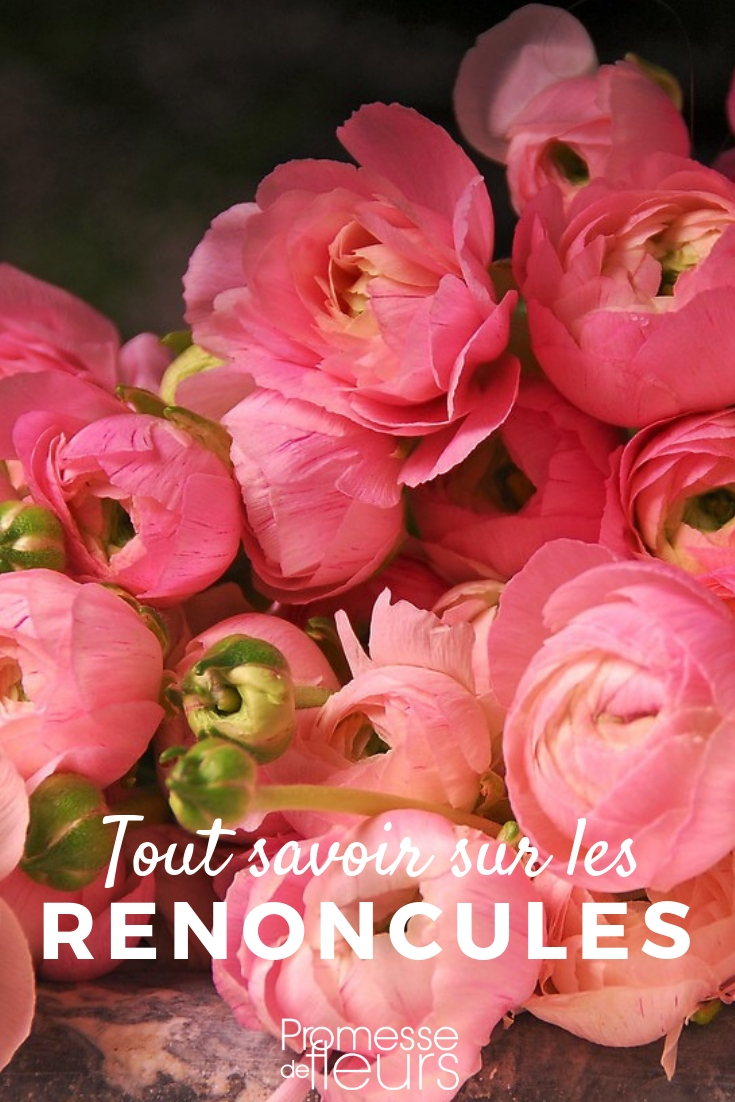































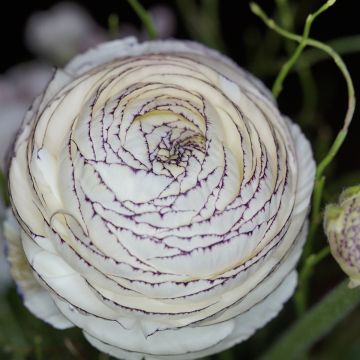
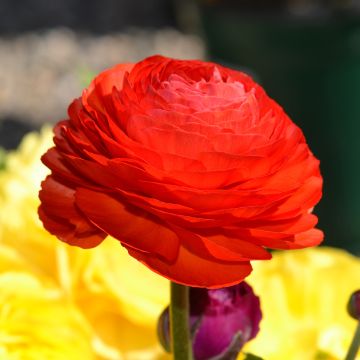
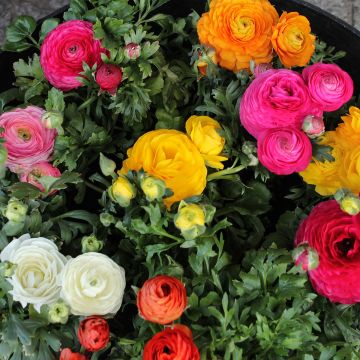
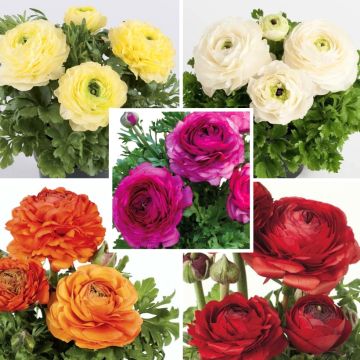


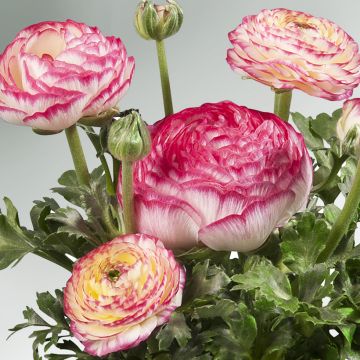


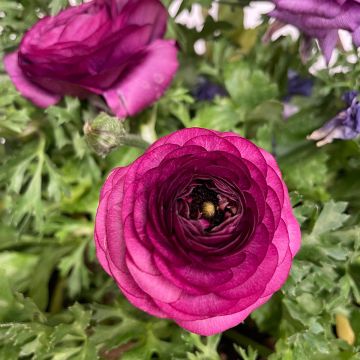
Comments